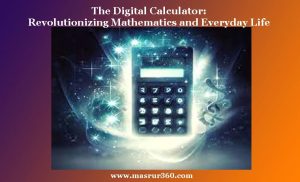The Digital Calculator: Revolutionizing Mathematics and Everyday Life
The Digital Calculator: Revolutionizing Mathematics and Everyday Life
Introduction
The digital calculator is an iconic tool that has played a pivotal role in revolutionizing mathematics and everyday life. From its humble beginnings as a mechanical device to its current form as a sophisticated electronic gadget, the digital calculator has undergone a remarkable transformation. In this comprehensive essay, we will delve into the history, evolution, technological advancements, and impact of digital calculators on education, science, business, and society as a whole.
I. Historical Development of Calculating Machines
1. Predecessors to Digital Calculators
The journey of the digital calculator can be traced back to ancient times when abacus-like devices were used for arithmetic calculations. These early tools laid the foundation for more sophisticated mechanical calculating devices in the 17th and 18th centuries.
2. The Mechanical Calculators
The 19th century witnessed the emergence of mechanical calculators such as Charles Babbage’s Difference Engine and Blaise Pascal’s Pascaline. These machines introduced the concept of automated arithmetic and inspired future innovations in computing.
3. The Birth of Digital Calculators
The mid-20th century marked a significant turning point with the invention of digital calculators. Pioneering devices like the Curta calculator and the Anita Mk VII paved the way for the electronic calculators that we are familiar with today.
II. Evolution of Digital Calculators
1. Early Electronic Calculators
In the 1960s, electronic calculators began to replace their mechanical counterparts. Devices like the Texas Instruments Datamath and the Hewlett-Packard HP-35 were among the first portable electronic calculators that gained widespread popularity.
2. Advancements in Technology
The 1970s and 1980s witnessed rapid advancements in calculator technology. Innovations such as liquid crystal displays (LCDs), microprocessors, and rechargeable batteries made calculators smaller, more powerful, and energy-efficient.
3. Graphing Calculators
The introduction of graphing calculators like the Texas Instruments TI-81 and TI-83 in the late 20th century revolutionized mathematics education. These devices allowed students to visualize mathematical concepts and solve complex equations.
4. Scientific Calculators
Scientific calculators, which offer a wide range of functions beyond basic arithmetic, became essential tools for scientists, engineers, and students pursuing STEM fields.
5. Programmable Calculators
Programmable calculators, like the HP-41C and Casio fx-7000G, allowed users to create custom functions and programs, expanding their utility beyond mere arithmetic.
III. Technological Features of Modern Digital Calculators
1. Display Technology
Modern calculators feature high-resolution displays with color capabilities, enhancing the presentation of graphs, charts, and equations.
2. Processing Power
Advanced microprocessors enable calculators to handle complex mathematical operations with speed and accuracy.
3. Connectivity
Many calculators now offer connectivity options, including USB ports and wireless capabilities, allowing users to transfer data and update software.
4. Storage and Memory
Expanded memory and storage capacity enable calculators to store equations, programs, and historical data for easy retrieval.
5. Software and Applications
Calculators often come with pre-installed software and a wide range of downloadable applications that cater to various mathematical and scientific needs.
IV. Impact of Digital Calculators
1. Education
Digital calculators have transformed mathematics education by simplifying calculations, promoting problem-solving skills, and enabling students to explore complex mathematical concepts with ease.
2. Scientific Research
Scientists and researchers rely on advanced calculators to perform intricate calculations, simulations, and data analysis in various fields, including physics, chemistry, and engineering.
3. Business and Finance
Financial professionals use calculators for complex financial modeling, investment analysis, and risk assessment, making them indispensable in the business world.
4. Everyday Life
Digital calculators have become ubiquitous in everyday life, assisting individuals with tasks ranging from budgeting and shopping to cooking and home improvement projects.
5. Accessibility
Digital calculators have made mathematics and science more accessible to individuals with disabilities, with features like screen readers and tactile buttons.
Conclusion
The digital calculator has evolved from its humble beginnings as a mechanical device to become an indispensable tool in education, science, business, and everyday life. Its historical development, technological advancements, and impact on society highlight its significance in the modern world. As technology continues to advance, digital calculators are likely to remain at the forefront of mathematical and scientific endeavors, empowering individuals and shaping the way we approach and solve complex problems. 0 0 0.
The Digital Calculator Varieties: Reviews
“The Digital Calculator Varieties” provides an insightful exploration of the evolution and diversity of digital calculators, examining their features, functionalities, and the contexts in which they are used. This review highlights the book’s strengths, weaknesses, and overall contribution to understanding digital calculators in both educational and professional settings.
Content and Structure:
The book is well-structured, divided into clear sections that cover:
History and Evolution: The author begins with a historical overview, tracing the development of calculators from mechanical devices to modern digital models. This section is rich with anecdotes and illustrations that enhance the narrative.
Types of Calculators: The book categorizes calculators into various types, including scientific, graphing, financial, and programmable calculators. Each category is discussed in detail, with examples of popular models and their specific applications.
Technical Features: A thorough examination of technical specifications is provided, including processing power, display types, and user interfaces. This section is particularly useful for readers seeking to understand the technical aspects of calculators.
Applications: The author highlights real-world applications of different calculators in fields such as engineering, finance, and education. This practical approach helps readers appreciate the relevance of calculators in various professions.
Future Trends: The book concludes with a discussion of emerging trends, such as the integration of calculators with smartphones and the rise of software-based calculators. This forward-looking perspective is valuable for readers interested in the future of technology.
Strengths:
- Comprehensive Coverage: The book offers a thorough examination of digital calculators, making it a valuable resource for both novices and experts.
- Engaging Writing Style: The author’s engaging prose, combined with relevant illustrations, keeps readers interested throughout.
- Practical Insights: The real-world applications and case studies provide practical insights, making the content relatable and applicable.
Weaknesses:
- Technical Jargon: Some sections may be dense with technical jargon, which could be challenging for readers without a background in mathematics or engineering.
- Limited Discussion on User Experience: While the book covers technical features extensively, it could benefit from more emphasis on user experience and usability studies.
Conclusion:
“The Digital Calculator Varieties” is an informative and well-researched book that serves as an essential guide to understanding the multitude of digital calculators available today. Its blend of historical context, technical detail, and practical application makes it a valuable resource for students, professionals, and enthusiasts alike. Despite minor shortcomings in accessibility, the book successfully highlights the significance of calculators in modern society and their continued evolution in the digital age. 0 0 0
Digital Calculator: Several Brands
Several brands of digital calculators are highly regarded for their quality, functionality, and reliability. Here are some of the most recommended brands:
Texas Instruments (TI)
- Popular Models: TI-84 Plus, TI-30X, TI-Nspire
- Features: Known for their graphing calculators, Texas Instruments models are widely used in schools and universities for their advanced features and user-friendly interfaces.
Casio
- Popular Models: Casio FX-991EX, Casio Graph 35+
- Features: Casio calculators are known for their durability and innovative features, including high-resolution screens and a variety of functions suitable for both students and professionals.
Hewlett-Packard (HP)
- Popular Models: HP 35s, HP Prime
- Features: HP calculators are appreciated for their RPN (Reverse Polish Notation) functionality and advanced scientific and graphing capabilities, making them popular among engineers and scientists.
Sharp
- Popular Models: Sharp EL-W516T, Sharp EL-531TH
- Features: Sharp offers a range of scientific and graphing calculators that are known for their affordability and solid performance, suitable for students and casual users.
Canon
- Popular Models: Canon F-715SG, Canon LS-123K
- Features: Canon calculators are often recognized for their eco-friendly designs and reliable performance, especially in basic and financial calculators.
Kalkulator
- Popular Models: Kalkulator 2.0 (for smartphones)
- Features: While not a traditional brand, the rise of calculator apps has made mobile solutions popular, with many users opting for feature-rich applications that offer great functionality.
Conclusion
When choosing a digital calculator, consider your specific needs—whether for scientific calculations, graphing, or financial tasks. Each of these brands offers reliable options that cater to various requirements, making them highly recommended in their respective categories. 0 0 0
You May Like:







